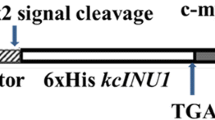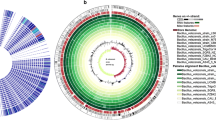Abstract
We report the molecular characterization of β-1,3-glucanase-producing Bacillus amyloliquefaciens—an endophyte of Hevea brasiliensis antagonistic to Phytophthora meadii. After cloning and sequencing, the β-1,3-glucanase gene was found to be 747 bp in length. A homology model of the β-1,3-glucanase protein was built from the amino acid sequence obtained upon translation of the gene. The target β-1,3-glucanase protein and the template protein, endo β-1,3-1,4-glucanase protein (PDB ID: 3o5s), were found to share 94 % sequence identity and to have similar secondary and tertiary structures. In the modeled structure, three residues in the active site region of the template—Asn52, Ile157 and Val158—were substituted with Asp, Leu and Ala, respectively. Computer-aided docking studies of the substrate disaccharide (β-1, 3-glucan) with the target as well as with the template proteins showed that the two protein-substrate complexes were stabilized by three hydrogen bonds and by many van der Waals interactions. Although the binding energies and the number of hydrogen bonds were the same in both complexes, the orientations of the substrate in the active sites of the two proteins were different. These variations might be due to the change in the three amino acids in the active site region of the two proteins. The difference in substrate orientation in the active site could also affect the catalytic potential of the β-1,3 glucanase enzyme.




Similar content being viewed by others
References
Melnick RL, Zidack NK, Bailey BA, Maximovad SN, Guiltinand M, Backman PA (2008) Bacterial endophytes: Bacillus spp. from annual crops as potential biological control agents of black pod rot of cacao. Biol Control 46:46–56
Rogers TH (1981) Natural rubber. In: McClure TA, Lipinsky ES (eds) CRC handbook of biosolar resources. CRC, Boca Raton
Jacob CK, Edathil TT, Idicula SP, Jayarathnam K (1989) Effect of abnormal leaf fall disease caused by Phytophthora sp. on the yield of rubber tree. Indian J Nat Rubber Res 2:77–80
Palumbo JD, Yuen GY, Jochum CC, Tatum K, Kobayashi DY (2005) Mutagenesis of beta-1,3-glucanase genes in Lysobacter enzymogenes strain C3 results in reduced biological control activity toward Bipolaris leaf spot of tall fescue and Pythium damping-off of sugar beet. Phytopathology 95:701–707
Cactano-Anolles G, Faueluken G, Beber WD (1993) Optimizations of surface sterilization for legume seed. Crop Sci 87:561–568
Miller GL (1959) Use of dinitrosalycilic acid reagent for determination of reducing sugar. Anal Chem 31:426–428
Lowry OH, Rosebrough NJ, Farr AJ, Randall RJ (1951) Protein measurement with the Folin phenol reagent. J Biol Chem 193:265–275
Pitcher DG, Nauders NA, Owen RJ (1989) Rapid extraction of bacterial genomic DNA with guanidium thiocyanate. Lett Appl Microbiol 8:151–156
Tamura K, Dudley J, Nei M, Kumar S (2007) MEGA4: Molecular Evolutionary Genetics Analysis (MEGA) software version 4.0. Mol Biol Evol 24:1596–1599
Sneath PHA, Sokal RR (1973) Numerical taxonomy. Freeman, San Francisco
Felsenstein J (1985) Confidence limits on phylogenies: an approach using the bootstrap. Evolution 39:783–791
Petersen TN, Brunak S, von Heijne G, Nielsen H (2011) SignalP 4.0: discriminating signal peptides from transmembrane regions. Nat Methods 8:785–786
Arnold K, Bordoli L, Kopp J, Schwede T (2006) The SWISS-MODEL workspace: a web-based environment for protein structure homologymodelling. Bioinformatics 22:195–201
Guex N, Peitsch MC (1997) SWISS-MODEL and the Swiss-PdbViewer: an environment for comparative protein modeling. Electrophoresis 18:2714–2723
Laskowski RA, MacArthur MW, Moss DS, Thornton JM (1993) PROCHECK: a program to check the stereochemical quality of protein structures. J Appl Crystallogr 26:283–291
DeLano WL (2002) The PyMOL molecular graphics system. DeLano Scientific LLC, San Carlos
Laurie AT, Jackson RM (2005) Q-Site Finder: an energy based method for the prediction of protein-ligand binding sites. Bioinformatics 21:1908–1916
Morris GM, Huey R, Lindstrom W, Sanner MF, Belew RK, Goodsell DS, Olson AJ (2009) AutoDock4 and AutoDockTools4: automated docking with selective receptor flexibility. J Comput Chem 30:2785–2791
Gomes RC, Sêmedo LTAS, Soares RMA, Linhares LF, Ulhoa CJ, Alviano CS, Coelho RRR (2001) Purification of a thermostable endochitinase from Streptomyces RC1071 isolated from a cerrado soil and its antagonism against phytopathogenic fungi. J Appl Microbiol 90:653–661
Boller T (1993) Antimicrobial functions of the plant hydrolases chitinase and β-1,3-glucanase. In: Fritig B, Legrand M (eds) Developments in plant pathology. Kluwer, Dordecht, pp 391–400
Ikai A (1980) Thermostability and aliphatic index of globular proteins. J Biochem 88:1895–1898
Noorbatcha IA, Ismail NI, Salleh HM (2011) Computer aided design of polygalacturonase II from Aspergillus niger. IIUM Eng J 12:189–196
Hardt M, Laine RA (2004) Mutation of active site residues in the chitin-binding domain ChBDChiA1 from chitinase A1 of Bacillus circulans alters substrate specificity: use of a green fluorescent protein binding assay. Arch Biochem Biophys 426:86–97
Mishra SK, Adam J, Wimmerova M, Koca J (2012) In silico mutagenesis and docking study of Ralstonia solanacearum RSL lectin: performance of docking software to predict saccharide binding. J Chem Inf Model 52:1250–1261
Acknowledgments
The authors are thankful for the facilities provided at Rubber Research Institute of India, School of Biosciences, Mahatma Gandhi University, Kottayam and Department of Biotechnology and Microbiology, Kannur University, Kannur. We express our sincere thanks to the Academic Frontier Program 070F010, Government of Japan for financially supporting S.P.N.
Author information
Authors and Affiliations
Corresponding author
Electronic supplementary material
Below is the link to the electronic supplementary material.
ESM 1
(DOC 1216 kb)
Rights and permissions
About this article
Cite this article
Abraham, A., Narayanan, S.P., Philip, S. et al. In silico characterization of a novel β-1,3-glucanase gene from Bacillus amyloliquefaciens—a bacterial endophyte of Hevea brasiliensis antagonistic to Phytophthora meadii . J Mol Model 19, 999–1007 (2013). https://doi.org/10.1007/s00894-012-1645-3
Received:
Accepted:
Published:
Issue Date:
DOI: https://doi.org/10.1007/s00894-012-1645-3




